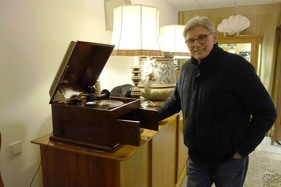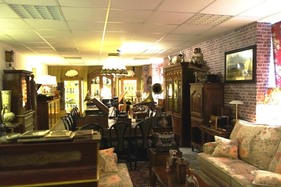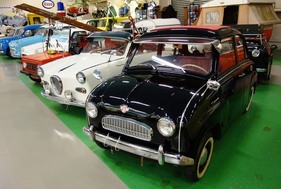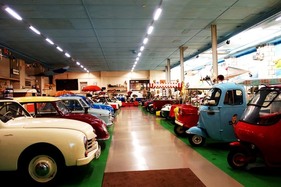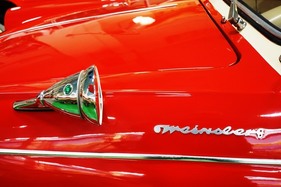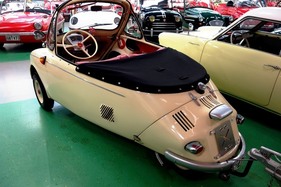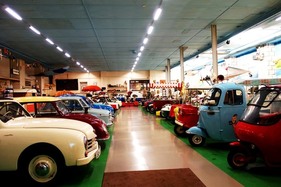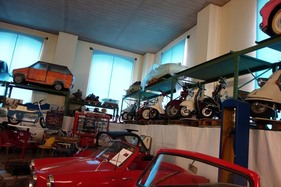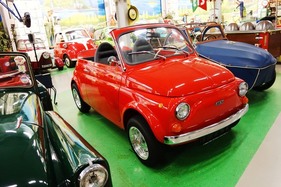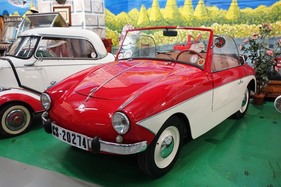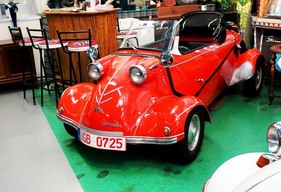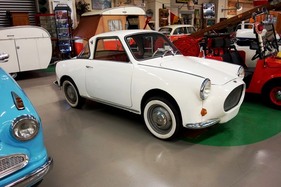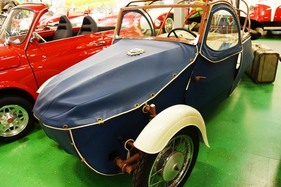Somewhere in St. Ingbert, a medium-sized town in the Saarland with an industrial past, Stefan Voit's private collection of historic small cars is housed in an old industrial building covering 900 square meters. It can be viewed by appointment by telephone.
Vehicles from the fifties and sixties are on display in a colorful campsite decoration. In addition to cars, there are also trailers, small caravans and two-wheelers. In keeping with the focus of this forum, however, the following explanations are limited to automobiles, i.e. small and very small cars.
It should be made clear in advance that the author of these lines is not one of those contemporaries who fall enraptured at the sight of an Isetta, for example. Rather, he still remembers the time when people were happy to have a "mobile base" at all in order to be able to drive to work "motorized". In those days, people didn't ride bicycles out of conviction, but rather for lack of more comfortable and faster, often covered vehicles. The small cars of the so-called economic miracle era are therefore not actually "cute" at all. Rather, they and their designers, who created something with simple means, deserve respect.
Small cars, big stories
Anyone who thinks that the Saarland exhibition is "over quickly" is very much mistaken. Of course, small and very small cars take up less space than US full-size cars - but above all, the busy host has a lot to tell the visitor. And that's why you should plan around 3 hours for the tour.
Collector Stefan Voit's interest is by no means limited to automobiles. Voit collects many things, for example all kinds of old radios, phonos, film and photographic equipment. In the decoration of the exhibition, you can therefore always discover collector's items, curiosities or long-forgotten things from your own childhood. Provided they date from after the Second World War and before 1970. This and an upper limit of approx. 600 cc displacement roughly define the scope of this excellent collection.
The exhibits are all in very good condition and have often been restored by the owner himself.
But how does one come up with the idea of collecting historic "microcars"? Voit, who is also a keen sportsman and motorcyclist, once discovered a Messerschmitt cabin scooter by chance at the Vespa stand at the motorcycle fair in Saarbrücken. To make a long story short: Due to a somewhat cheeky remark to one of his sons, he suddenly saw himself in the word and acquired one at the drop of a hat. And since he obviously couldn't suppress his collector's gene in the following years, many a small or very small car was added...
Between old acquaintances and new friends
On a tour, you naturally tend to greet the supposedly old acquaintances first. Sure: Isetta, Goggo, Messerschmitt and Heinkel Kabine immediately catch the visitor's eye. Because at first they only see what they want to see. But even at second glance, rarer vehicles such as Gutbrod, Maico, Fuldamobil or Kleinschnittger, Zündapp Janus and other curiosities can be discovered.
Incidentally, these do not always have to be original - for example, there was never officially a Heinkel cab as a (in my opinion, stylistically successful) "roadster", nor did the factory offer a "cut-open" Fiat 500 at the time. Originality fetishists may not appreciate this - but it is always interesting. And here - in the midst of rarities, one-offs and prototypes - it simply fits.
The special attraction of this collection lies in the fact that the head of the collection - who does not see it as a museum and therefore does not refer to it as such - has an exciting story to tell about every exhibit - "every car tells a story", so to speak. This can relate to the technology or the history of the creation of the small car, or to the convoluted way in which the car found its way into the Saarland collection.
From all over the world
Let's start our tour by picking out a few cars that the reporter has seen for the first time: The Pengor Penguin, for example, can be discovered, a unique specimen of a tiny four-seater amphibious vehicle with the BMW logo emblazoned on the front. It was built in Canada in 1965 and once belonged to the industrialist and BMW shareholder Harald Quandt, which would explain the rather joking emblem.
The Norsjö Shopper from Sweden, a three-wheeled vehicle from the 50 cc class with a front door similar to the Isetta, but open at the rear, seems somewhat bizarre to me.
The Velorex from the Czech Republic, another three-wheeled vehicle built until the 1970s, also takes some getting used to. Its body is made of fabric stretched over a tubular frame.
Even rarer is probably the pretty little PTV 250 sports car from Spain with its tasteful two-tone paintwork. The example shown here is the only one outside Spain.
The Meister K 5 from Austria, which was offered as a driver's license-free city car, provided a roof over the head, although for once it dates back to the 1970s. The red/white Champion CH-2 from 1949 is in perfect condition and comes from the collection of Bruce Weiner, whose collection of "microcars" was auctioned off in 2013 to great media attention. At that time, an FMR Tg 500 "Tiger" achieved a record price. Needless to say, there is also an example of this legendary four-wheeled cabin scooter in the Voit collection. There are actually two of them, as a 1:1 scale sculpture of the "Tiger" welded together from iron parts can be found right next to it.
The prototype of the (Buckle) Goggomobil Dart, a sporty, doorless roadster with a plastic body based on the Goggomobil, is undoubtedly a special rarity. The example on display was built in Australia and brought to Munich in a Lockheed Super Constellation. After getting the okay from Glas, the Buckle company started small series production in Australia.
Stefan Voit always explains his cars in an entertaining and humorous way - for example, when he opens the rather oversized hood of the British Bond Three-Wheeler and demonstrates that the vehicle can practically turn on the spot.
The author also found the exhibited replica of a Glas Isar S 35 remarkable. This vehicle, which was presented at the IAA 1959, is a sporty coupé with the modified body of the Goggo coupé, recognizable by the front-hinged doors and a striking plastic snout. It was to be fitted with the boxer engine from the Isar T 700 and stand on 12-inch wheels. But the S 35 never came onto the market. The sales brochures had already been printed, but then the manufacturer backed out. It's nice that this project is documented here.
Forgotten thanks to intended use
The great merit of the Voit Collection is that it presents an astonishing range of small vehicles from the post-war period, whose significance is brought to life by the enthusiastic collector's vivid explanations. Looking at an original Goggomobil TL 250 of the German Federal Post Office, one realizes that this small and practically designed panel van served its purpose long before the Volkswagen "Fridolin", which later became famous.
And there is no doubt that the six-seater Lloyd LP 600 is the ancestor of the type of vehicle that was only called a "van" decades later. The Voit collection contains vehicles that were significant and justified at the time. Often they have only fallen into oblivion because they were used for their intended purpose or because they lacked the potential to become a speculative investment. Nevertheless, these simple, often minimalist vehicles are genuine engineering achievements and significant in terms of automotive history.
At the end of my tour, the host talks about his other collections - such as unusual mechanical toys made in Japan for the US market. And at the very end, the humorous head of the collection has a riddle for me in the form of a palm-sized apparatus. The solution is revealed here for a change: It is a grinding machine for razor blades. The reporter had never seen anything like it before either...
Vintage car collection Voit
A visit is only possible for groups (ideally 10 to 15 people) by prior appointment by telephone. Reservations can be made by calling +49 (0) 171 975 50 07.















































































































